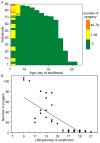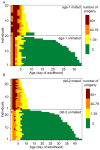Fertility/longevity trade-offs under limiting-male conditions in mating populations of Caenorhabditis elegans
- PMID: 22771817
- PMCID: PMC3437009
- DOI: 10.1016/j.exger.2012.06.010
Fertility/longevity trade-offs under limiting-male conditions in mating populations of Caenorhabditis elegans
Abstract
Evolutionary theories of aging suggest that trade-offs between longevity and fitness should be found under certain conditions. In C. elegans, there is little evidence for the existence of such trade-offs. We asked if fertility/longevity trade-offs exist in populations of randomly mating males and hermaphrodites. We set up a large population of young males and 5-day-old hermaphrodites that were no longer self-fertile. We then allowed them to mate for one day with an equal number young males and then separated hermaphrodites to individual plates and determined daily fertility of individual hermaphrodites. There was a significant negative relationship between late-life fertility and individual longevity.
Copyright © 2012 Elsevier Inc. All rights reserved.
Figures




Similar articles
-
Longevity in Caenorhabditis elegans reduced by mating but not gamete production.Nature. 1996 Feb 22;379(6567):723-5. doi: 10.1038/379723a0. Nature. 1996. PMID: 8602217
-
Mating damages the cuticle of C. elegans hermaphrodites.PLoS One. 2014 Aug 8;9(8):e104456. doi: 10.1371/journal.pone.0104456. eCollection 2014. PLoS One. 2014. PMID: 25105881 Free PMC article.
-
[Male Caenorhabditis elegans could enhance the population's resistance against heat stress].Ying Yong Sheng Tai Xue Bao. 2012 Aug;23(8):2036-40. Ying Yong Sheng Tai Xue Bao. 2012. PMID: 23189676 Chinese.
-
Investigating Connections between Metabolism, Longevity, and Behavior in Caenorhabditis elegans.Trends Endocrinol Metab. 2016 Aug;27(8):586-596. doi: 10.1016/j.tem.2016.05.004. Epub 2016 Jun 9. Trends Endocrinol Metab. 2016. PMID: 27289335 Free PMC article. Review.
-
Chemical mating cues in C. elegans.Semin Cell Dev Biol. 2014 Sep;33:18-24. doi: 10.1016/j.semcdb.2014.06.002. Epub 2014 Jun 27. Semin Cell Dev Biol. 2014. PMID: 24977334 Review.
Cited by
-
Self-sperm induce resistance to the detrimental effects of sexual encounters with males in hermaphroditic nematodes.Elife. 2019 Jul 8;8:e46418. doi: 10.7554/eLife.46418. Elife. 2019. PMID: 31282863 Free PMC article.
-
Caenorhabditis elegans Genes Affecting Interindividual Variation in Life-span Biomarker Gene Expression.J Gerontol A Biol Sci Med Sci. 2017 Oct 1;72(10):1305-1310. doi: 10.1093/gerona/glw349. J Gerontol A Biol Sci Med Sci. 2017. PMID: 28158434 Free PMC article.
-
Dramatic fertility decline in aging C. elegans males is associated with mating execution deficits rather than diminished sperm quality.Exp Gerontol. 2013 Nov;48(11):1156-66. doi: 10.1016/j.exger.2013.07.014. Epub 2013 Aug 2. Exp Gerontol. 2013. PMID: 23916839 Free PMC article.
-
Mating induces shrinking and death in Caenorhabditis mothers.Science. 2014 Jan 31;343(6170):536-40. doi: 10.1126/science.1242958. Epub 2013 Dec 19. Science. 2014. PMID: 24356112 Free PMC article.
-
Microbes are potential key players in the evolution of life histories and aging in Caenorhabditis elegans.Ecol Evol. 2023 Sep 25;13(9):e10537. doi: 10.1002/ece3.10537. eCollection 2023 Sep. Ecol Evol. 2023. PMID: 37753311 Free PMC article.
References
-
- Ayyadevara S, Alla R, Thaden JJ, Shmookler Reis RJ. Remarkable longevity and stress resistance of nematode PI3K-null mutants. Aging Cell. 2008;7:13–22. - PubMed
Publication types
MeSH terms
Grants and funding
LinkOut - more resources
Full Text Sources

